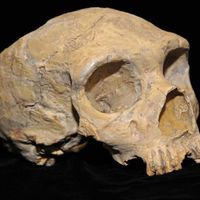ABOVE: A Neanderthal skull
WIKIMEDIA, AQUILAGIB
Neanderthals, modern humans’ closest evolutionary relatives, have been extinct for thousands of years. But due to interbreeding between the two groups around 55,000 years ago, remnants of our long-lost kin remain in the genetic material of individuals alive today. Scientists have previously suggested Neanderthal DNA was gradually removed from modern human genomes during the last 45,000 years. But a new study, published last week in PNAS, reports that Neanderthal ancestry in Europe likely experienced a quick purge from modern humans’ genomes but then held steady since then.
Neanderthal DNA makes up approximately 2 percent of the genomes of present-day people of non-African descent (researchers believe that Neanderthals intermingled with modern humans after they emerged from Africa). Several studies suggest that Neanderthals may have harbored sequences that were deleterious for modern humans and therefore were expunged from the DNA of our ancestors. For...
Evidence that Neanderthal communities were much smaller than human ones have led researchers to believe that weakly harmful variants—which would have been quickly removed from bigger groups with more genetic diversity—accumulated in Neanderthal genomes. “When populations are smaller, [natural] selection isn’t as strong,” explains Benjamin Vernot, a population geneticist at the Max Planck Institute for Evolutionary Anthropology and one of the coauthors of the latest study. “So on average, Neanderthals would have had more bad mutations in their genome than modern human individuals.”
See “Effects of Neanderthal DNA on Modern Humans”
While studies have generally supported the hypothesis that modern human genomes shed any untoward traces of Neanderthal DNA, how this process occurred was unclear.
According to Vernot, his team’s investigation stemmed from two studies—one experimental and one theoretical—that reported somewhat contradictory findings. One was a 2016 Nature article coauthored by more than 60 scientists, including three of the investigators who were involved in the latest study, that examined the genetic material of 51 ancient Eurasians and reported a continuous loss of Neanderthal DNA in European populations over 45,000 years.
In the other report, published the same year in Genetics, a different team conducted simulations to model what would have happened if Neanderthals did indeed accrue mutations much more quickly than modern humans. This revealed that rather than slowly declining over time, Neanderthal DNA in modern human genomes would have rapidly decreased during the first 10 to 20 generations after the two groups interbred, a time period of less than 1,000 years, then remained unchanged throughout future generations.
Vernot and his colleagues set out to identify whether a different model of natural selection could explain the gradual decrease of Neanderthal DNA in ancient Eurasian genomes. “We tried a bunch of things and none of them worked,” Vernot says. “We drove ourselves nuts trying to figure out how to make this decline over time, because that’s what we saw in the data.”
Eventually, the team decided to go back and try to reanalyze the ancient genomes themselves. That’s when they spotted the problem: the statistic used in the Nature study coauthored by Vernot’s collaborators. They applied it to estimate the degree of Neanderthal ancestry in modern humans, but it included assumptions about the history of modern humans such as a lack of migration between certain populations. So Vernot’s group analyzed the data with an updated statistic that did not make any of those presumptions—and took advantage of an additional Neanderthal genome that was characterized in 2017—and found no change in Neanderthal ancestry over the last 45,000 years.
“[This study] is a cautionary tale that you should think about migration because it can make a difference in your conclusions, even if it’s not what you want to study right now,” says Kelley Harris, a population geneticist at the University of Washington who coauthored the 2016 Genetics paper and was not involved in Vernot’s study.
In subsequent analyses, the researchers found that the best model to fit these newly analyzed data was one in which Neanderthal sequences were rapidly removed from modern human genomes within around 10 generations after interbreeding, rather than gradually lost over many thousands of years—just as the authors of the Genetics study had previously reported. Vernot points out that as investigators haven’t unearthed samples from humans who lived during time period immediately after intergroup mating, this theory has yet to be confirmed.
Mark Lipson, a staff scientist in geneticist David Reich’s lab at Harvard Medical School who wasn’t involved in the study but is mentioned in the paper’s acknowledgements, says that while this was “a thought-provoking paper” that made him question the idea of the gradual decline in Neanderthal ancestry, it hasn’t convinced him completely. Lipson—one of the coauthors of the 2016 Nature study—adds that more analyses, and perhaps more DNA samples, are needed to completely invalidate the original hypothesis.
See “Inner Neanderthal”
Vernot’s team also used the new statistic to investigate the change in Neanderthal sequences in different parts of the modern human genome over time. This revealed that while very little depletion occurred in genes, which make up around 2 percent of total DNA, loss was visible in regulatory sequences, which make up less than 1 percent. According to Vernot, these findings fit well with prior studies that have shown that Neanderthal sequences associated with disease in modern humans are often found in regulatory regions. He notes that more work needs to be done to figure out whether those sequences were removed from many modern human genomes because they were deleterious. “We [also] still don't know why regulatory sequences would have been worse than gene sequences,” Vernot says. “This would be an interesting thing to follow up on.”
M. Petr et al., “Limits of long-term selection against Neandertal introgression,” PNAS, doi:10.1073/pnas.1814338116, 2019.
Interested in reading more?







